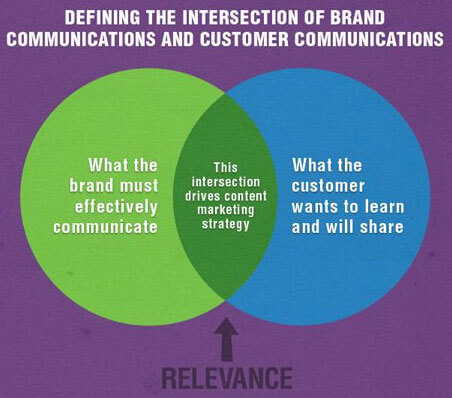Smart Insights teamed up with HubSpot to produce new research on content marketing. They asked 768 marketers based in Europe how they planned to use content marketing in their business in 2015. The results of their research are below:
Relevance is the intersection of what the brand must effectively communicate and what the customer wants to learn and will share. Here are 7 steps to success competing with content marketing.
Step 1: Benchmark Your Current Use of Content Marketing
Start by reviewing your previous content marketing efforts. Fewer than a third of businesses have an optimized or advanced approach to content marketing.
Assess how well content marketing currently works for you, review:
- Previous content engagement and amplification using analytics
- How you evaluate return-on-investment
- How well you plan and schedule
- The quality of your content assets and formats
- The quality of seeding and paid content distribution
Step 2: Develop a Content Marketing Strategy
The majority of businesses don’t have one. Take control of your content marketing with a defined strategy.
Creating a content marketing strategy will help you:
- Determine where you need to invest to compete
- Make the business case to invest
- Set goals and link to ROI tracking using analytics
- Integrate your content marketing with business goals
Step 3: Understand Customer and Brand Needs from Content
Use the best analysis techniques to find the intersection of business and customer needs.
We recommend using these content marketing planning techniques:
- Customer persona creation
- Customer journey mapping
- Content marketing matrix
- Editorial calendars
- Effective outreach analysis
- Using analytics for ROI / value assessment
Step 4: Make the Smart Investments in Content Marketing
Many businesses are investing more in content marketing. Does your level of investment allow you to be competitive?
Ensure you’re investing wisely:
- Content creation: Is quality and update frequency sufficient to compete?
- Paid AdWords or Advertising network promotion: Pay for content to engagement
- Paid social distribution: The Big 5 Social Networks have many targetting opportunities
- Strategy and editorial: Plan to Succeed!
Step 5: Select the Best Mix of Resources
Savvy companies use a mix of in-house an agency resource.
Choose the best mix of in-house and external agency and content resources:
- Content strategy: In-house control important
- Content creation: Paying for quality content can help cut-through
- Outreach and PR: Use agency contacts and networks
- Paid promotion of content assets: Agencies may have specialist tools and techniques
Step 6: Create the Most Effective Content Formats
Investigating in content customers value is the key to success.
Use the content marketing matrix to select the best content by:
- Defining audience needs using personas
- Plotting existing brand and competitor content use
- Brainstorming new content ideas
- Prioritizing new content based on agreed success criteria
Step 7: Use Analytics to Review ROI and Value
Many don’t get value from their analytics, the leaders do.
Setup and regularly review analytics to improve results:
- Define the right content marketing KPIs
- Define goal value in Analytics to calculate ROI
- Don’t forget qualitative feedback tools
- Review performance to learn and improve


